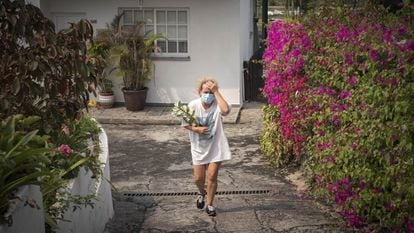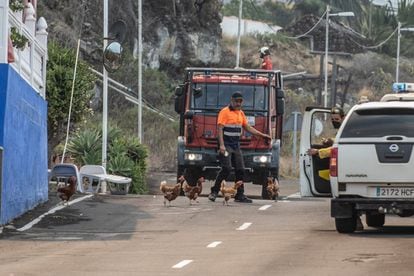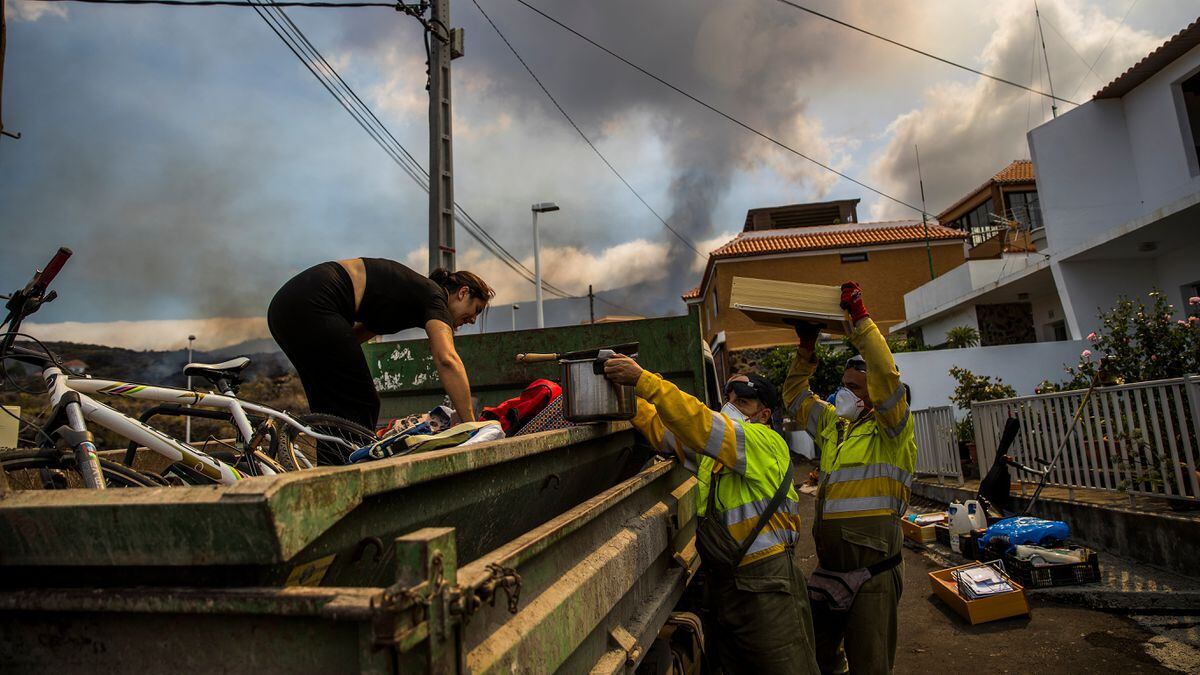‘We took everything we could. First the sentimental things, photos, paintings…’
As the lava on La Palma advances, residents of the Todoque neighborhood of Los Llanos are given one hour to rescue what they can from their homes before these are likely engulfed by the molten rock

In a corner of the town of Los Llanos, on the island of La Palma in Spain’s Canary Islands, there is a line of three or four very agitated people, waiting at a Civil Guard checkpoint that is stopping them from accessing their neighborhood. One of them, Carmen Santos, is crying. She is aged around 40. Next to her, there is a man wearing a t-shirt and shorts, aged 65, whose name is José Carlos González. They are obsessively monitoring the road that leads to the Todoque neighborhood. Carmen, who lives there and was evacuated from her home on Sunday, is shouting. “When will be able to enter? The mayor called me and told me I have one hour to get what I can out of there.”
A Civil Guard chief approaches them. Politely, and trying to calm the situation, he says to them: “Soon. All of you will be able to go in. But it has to be done in order, to avoid looting. And accompanied by a firefighter or a police officer.”
Carmen and José look at them. They nod. The civil guard adds: “You will go in and out quickly. You’re going to take the most essential items with you. Because it will happen soon.” What will “happen soon” is that a mountain of lava measuring more than six meters high and that is progressing at a snail’s pace toward the neighborhood is going to crush their house along with everything that is in it.
“Essential items? What does essential items mean?” Carmen asks herself, without daring to reply. At that moment, a very thin man arrives, and in a quiet voice he asks: “Is this the line to enter the houses in Todoque?” They reply that it is, and he waits his turn at the back, without saying another word.
Within a few days, all this will be unrecognizable, the houses will have disappeared, as well as the sidewalks and the plotsA civil guard on the scene
Todoque, home to 1,500 residents, was evacuated on Monday, the day after an as-yet-unnamed volcano, located in Cabeza de Vaca, erupted at around 3.15pm on Sunday. Like most of the 5,000 people who have been evacuated on the island, the inhabitants of this part of Los Llanos took refuge in the homes of relatives or friends. Carmen explains that when she left her home on Sunday, she did so very calmly, with the idea that in a few days she could return, and that all of this would just be a nightmare that lasted a few days or a week. That was until Tuesday morning, when the local council warned her that she had just an hour to rescue her things.
The civil guard approaches the group waiting in line once more, and one by one he gives them permission to pass. They are directed to a car and are accompanied by a firefighter. Carmen gets onto one of the vehicles together with two other people and enters Todoque.
The neighborhood resembles a city that is facing the end of the world. It’s the other side of the spectacle of the erupting volcano. There is no one on the street apart from those who are inside vans that are either empty or packed to bursting. All of the stores are closed. There are chickens running loose in an alleyway. Albeit on a different scale, the scene resembles the photos of Chernobyl several days after it was evacuated due to the explosion at the nuclear power plant in the Ukrainian city back in the 1980s.

On one wall, there is a sign that says “Caroli’s Hair Salon,” as well as a welcome sign in German. Next to it, there is a table and some chairs that appear to have been abandoned just five minutes before. A few hundred meters away, a mountain of lava is sliding down the hill. And further back, the volcano is visible, making a sound that resembles a jet engine and that rings out every once in a while.
Black ash that looks like sand is floating through the air, sticking to your hair, face and arms. It crunches when you step on it, as if you were walking on gravel. There are firefighters, police officers and civil guards on the corners, observing the scene. There are also members of the Military Emergency Unit (UME), who are further up the mountain, monitoring the lava. A scientist from Venezuela asks a firefighter if they are carrying out any studies about the velocity of the emissions. And on another corner, there is a civil guard with a Canary Islands’ accent who is cursing the volcano, and explaining that a few hours ago he had to use force to evacuate a woman who refused to leave her home.
On the sidewalk is Oliver Carmona, 33. Sweating and weary, he is looking toward the burning hillside that is sliding downward, and then at a white house on the right. He has come to help out his friend, who owns the white house, which is right in the path of the lava as it makes its slow progress toward the sea. In all probability, the molten rock will end up devouring the property. “It’s in the eye of the storm,” he says. “We took everything we could. Everything we could. First the sentimental things, the photos, the paintings…”

The lava is moving slower than expected, which means there is more time to empty out the houses. In one of them, which has all its doors open, a strong, tall man, aged around 40, is piling possessions onto a truck, with the help of his son and employees of both the island and local councils. The civil guard with the Canarian accent explains that the first things they need to grab are the deeds to the property. “Because within a few days, all this will be unrecognizable, the houses will have disappeared, as well as the sidewalks and the plots, so documents will be needed to certify who the land belongs to.”
Later, he is chatting with an employee from the local council, who is complaining about the politicians. “We need to take advantage of this and make demands,” he says. “When all this cools down, no one will demand anything from them on the peninsula. And we will need to rebuild the houses, reinstall the pipes, the electricity, replant the crops…”
A terrifying advance
Meanwhile, the municipal workers have finished emptying out the house of the man they were helping, and he asks a journalist for a pen. On his hand, he makes a note of the phone number of someone at the local council who will be able to help him out with a future task. He then says goodbye and thanks everyone who helped him clear out his house. He hugs a photographer who is trying in vain to comfort him, and then is on his way, leaving behind his house just like dozens of other people have done in Todoque: with the doors open, cardboard boxes everywhere and empty coathangers in the closets.
The advance of the mountain of lava is slow but clear to see. It is also terrifying. Further down the hillside, there is the house belonging to Oliver Carmona’s friend. It’s pretty and well-taken care of, and has a swimming pool and flower beds. The owners, their friends and council employees are all rushing to empty it. They are piling everything they can onto a van: a bicycle, a pair of cushions, a ladder, a fridge… Nearby, a young woman who is likely the owner of the house, cries as she closes the trunk of the car, which is packed with possessions. She then enters the house to emerge later with a load of paintings. One of the friends points to one of the vans and says: “All of this to Kity’s house.” Others nearby, under the falling ash, are loading up another small truck: a nightstand, a mattress, a basket with bags of lentils and chickpeas, a bucket filled with clothes…
English version by Simon Hunter.

/cloudfront-eu-central-1.images.arcpublishing.com/prisa/OMIHPY7KWVA7LOQYMIPS5WT7I4.jpg)
/cloudfront-eu-central-1.images.arcpublishing.com/prisa/P5X4LUOSPBHL23MHYG2T33X4EA.jpg)










































